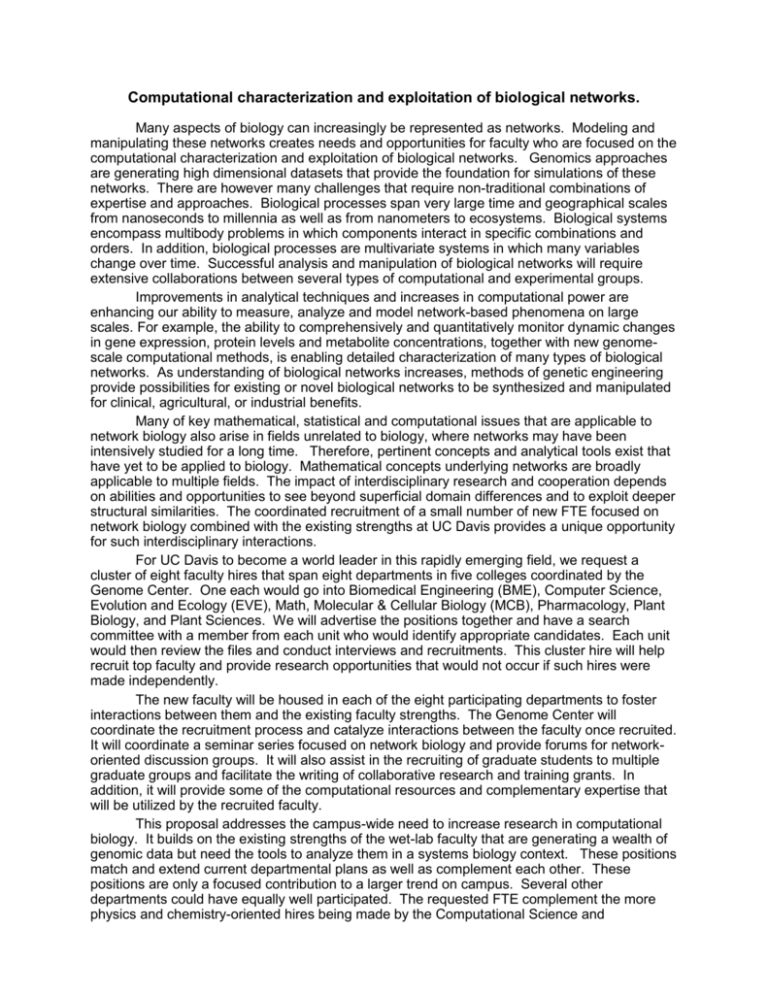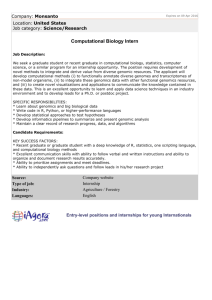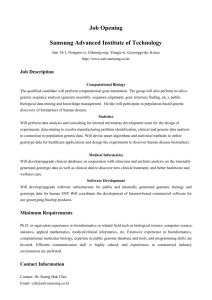DRAFT STRATEGIC FTE PROPOSAL:
advertisement

Computational characterization and exploitation of biological networks. Many aspects of biology can increasingly be represented as networks. Modeling and manipulating these networks creates needs and opportunities for faculty who are focused on the computational characterization and exploitation of biological networks. Genomics approaches are generating high dimensional datasets that provide the foundation for simulations of these networks. There are however many challenges that require non-traditional combinations of expertise and approaches. Biological processes span very large time and geographical scales from nanoseconds to millennia as well as from nanometers to ecosystems. Biological systems encompass multibody problems in which components interact in specific combinations and orders. In addition, biological processes are multivariate systems in which many variables change over time. Successful analysis and manipulation of biological networks will require extensive collaborations between several types of computational and experimental groups. Improvements in analytical techniques and increases in computational power are enhancing our ability to measure, analyze and model network-based phenomena on large scales. For example, the ability to comprehensively and quantitatively monitor dynamic changes in gene expression, protein levels and metabolite concentrations, together with new genomescale computational methods, is enabling detailed characterization of many types of biological networks. As understanding of biological networks increases, methods of genetic engineering provide possibilities for existing or novel biological networks to be synthesized and manipulated for clinical, agricultural, or industrial benefits. Many of key mathematical, statistical and computational issues that are applicable to network biology also arise in fields unrelated to biology, where networks may have been intensively studied for a long time. Therefore, pertinent concepts and analytical tools exist that have yet to be applied to biology. Mathematical concepts underlying networks are broadly applicable to multiple fields. The impact of interdisciplinary research and cooperation depends on abilities and opportunities to see beyond superficial domain differences and to exploit deeper structural similarities. The coordinated recruitment of a small number of new FTE focused on network biology combined with the existing strengths at UC Davis provides a unique opportunity for such interdisciplinary interactions. For UC Davis to become a world leader in this rapidly emerging field, we request a cluster of eight faculty hires that span eight departments in five colleges coordinated by the Genome Center. One each would go into Biomedical Engineering (BME), Computer Science, Evolution and Ecology (EVE), Math, Molecular & Cellular Biology (MCB), Pharmacology, Plant Biology, and Plant Sciences. We will advertise the positions together and have a search committee with a member from each unit who would identify appropriate candidates. Each unit would then review the files and conduct interviews and recruitments. This cluster hire will help recruit top faculty and provide research opportunities that would not occur if such hires were made independently. The new faculty will be housed in each of the eight participating departments to foster interactions between them and the existing faculty strengths. The Genome Center will coordinate the recruitment process and catalyze interactions between the faculty once recruited. It will coordinate a seminar series focused on network biology and provide forums for networkoriented discussion groups. It will also assist in the recruiting of graduate students to multiple graduate groups and facilitate the writing of collaborative research and training grants. In addition, it will provide some of the computational resources and complementary expertise that will be utilized by the recruited faculty. This proposal addresses the campus-wide need to increase research in computational biology. It builds on the existing strengths of the wet-lab faculty that are generating a wealth of genomic data but need the tools to analyze them in a systems biology context. These positions match and extend current departmental plans as well as complement each other. These positions are only a focused contribution to a larger trend on campus. Several other departments could have equally well participated. The requested FTE complement the more physics and chemistry-oriented hires being made by the Computational Science and Engineering Center. The impact of these eight FTE will be felt well beyond the eight participating departments. The position in BME will aim to elucidate the design principles for biological networks in their complex natural setting, to employ these principles for the re-design of dysfunctional networks, and to design, construct and evaluate synthetic biological networks with therapeutic potential. A component of this research will be aimed at understanding the robustness and the sensitivity of biological networks in a noisy environment that may be a key issue in controlling responses of biological networks. This will allow the manipulation of biological networks for translational research aimed at clinical application, based on principles to guide the design process and understanding of the functional consequences of genetic manipulations. This position will complement the current strengths in BME in system level study of genetic networks and signal transduction networks using engineering principles. The position in Computer Science will apply approaches developed for diverse types of networks. The study of networks in biology is an active and natural topic for computer science, since computer science has long been concerned with networks in many applications (communication networks, networks of computers, networks as data-structures, and networkflow and graph-theoretic algorithms in addition to direct applications in biology). Computer scientists are now active in three major topics in the study of networks in biology: the characterization and analysis of regulatory and metabolic networks; the characterization and exploitation of networks of biological interactions extracted by text mining the huge databases of biological literature; the inference of phylogenetic and genealogical networks that are the key to understanding reticulated evolution, driven by genomic data that are not well-suited to tree models. Research in Computer Science will mesh well with the group developing in Mathematics and will complement laboratory studies of biological networks in multiple departments. The position in EVE will utilize comparative genomics to analyze genomic networks that occur at both the intracellular level, involving the interactions that specify phenotypes and govern metabolism, and at the population genetic level, involving non-bifurcating genealogical networks produced by recombination and selection. This will extend our studies of evolutionary biology that span all levels of biological organization: from molecules and molecular pathways to phenotypes, populations, and ecosystems. Genetic networks occur at all levels of organization including the intracellular level, involving the interactions that specify phenotypes and govern metabolism; the population level, involving non-bifurcating genealogical networks produced by recombination and selection; and the level of inter-specific relationships. Networks at all of these levels are receiving increasing attention from evolutionists. For instance, a central postgenomic question is how developmental pathways translate molecular variation into phenotypic variance and evolutionary divergence. Similarly, we are just beginning to understand how to analyze the genealogical networks that characterize the history of most eukaryotic DNA sequences, whose transmission involves sexual reproduction and recombination. The current EVE academic plan involves hires in both theoretical population genetics and comparative genomics/phylogenomics. EVE would provide a productive environment for an FTE that addresses genomic networks and comparative genomics. The position in Math will apply nonlinear dynamical systems to the mathematical modeling of molecular pathways. This position is consistent with the academic plan of the Department of Mathematics to expand their existing strengths in partial differential equations, mathematical physics, and geometric topology where dynamical systems play a central role. One of the most exciting areas of nonlinear dynamical systems is the mathematical modeling of biochemical pathways. The dynamics of such a system will include rate equations for each reaction step in the pathway, plus the equations governing the expression of the genes and the synthesis of their proteins. The systems involved will include nonlinear equations with many unknowns. Because of the small numbers of molecules involved, stochastic effects are expected to be important. The mathematical models needed for full simulations are thus expected to be complex. The identification of good paradigm problems that are simple enough to be tractable and characterized sufficiently to make modeling possible as well as biologically important enough so that the utility of the modeling is evident to wetlab scientists, will require close collaborations with biologists. The proposed initiative places the Mathematics Department in an ideal position in its pursuit of its long term goal of increasing research collaborations with biological sciences. The position in MCB will focus on the computational analysis of metabolic and developmental networks. Both the maintenance of normal cellular homeostasis and the development of complex multicellular organisms are dependent on the precise regulation of molecular networks. In metabolism, the flux of molecules through specific biochemical pathways and the regulation of these pathways play a key role whereas the precise temporal regulation of gene expression is essential for normal development. Integration of computational biology with wet-lab experimentation will provide new insights into how these networks function. This FTE would make a key contribution to MCB’s academic plan that emphasizes biochemistry and developmental biology. The position in Pharmacology will exploit the rapidly increasing amounts of proteomic data that are being generated as the result of increased resolution and throughput of mass spectrometers as well as other approaches such as protein microarrays. Such proteomic analyses are critical to the analysis of the components and dynamics of protein interaction networks. Our ability to generate proteomics data has exceeded the tools to analyze it. This position will focus on devising and implementing new statistical and computational approaches to analyze proteomic data such as statistical models that predict and test the stoichiometry, stability, and dynamics of macromolecular protein complexes as well as computational methods to compare quantitative datasets generated by microarray and proteomics data. This FTE will closely complement the recent Genome Center hires into Pharmacology and MCB who are involved in wet lab proteomics research. The FTE in Plant Biology will be an experimentalist who uses computational approaches to analyze for example hormone signaling, long-distance cellular communication networks, or developmental responses to light or other environmental cues. The positions in Plant Biology and Plant Science will exploit several unique features of plants that make them excellent models for biological networks. Plants can be grown in large numbers under controlled environments and exhibit a much wider range of developmental responses to environmental stimuli than animals, making them ideal for quantitative modeling of interactions of multi-cellular organisms with their environment. Plants also exhibit a high degree of intra-specific genetic polymorphism relative to animals; such diversity provides both natural variants and molecular markers to allow rapid identification of the genetic components underlying the observed responses. The data generated in the research by this FTE will allow the construction of models for gene networks, metabolic pathways, long-range communications, and responses to external signals. A longterm goal is to model a “virtual plant”. This FTE will complement existing strengths in plant research at UC Davis and will allow UC Davis to maintain its leading position in plant biology. The FTE in Plant Sciences will be a quantitative geneticist who will develop and apply methods for high-throughput and high-resolution identification of quantitative trait loci and analysis of the phenotypic consequences of natural allelic variation. Domesticated and natural plant systems provide excellent models to understand the underlying relationship between phenotype and genotype. Genomic technologies now in place at the Genome Center, the Plant Genomics Program and the Department of Plant Sciences provide the platform for large-scale genotyping and phenotyping in plant populations. New theoretical and computational methods are required to mine between the large multi-dimensional datasets that will be generated. Such methods are rooted in quantitative genetic and statistical theory. Quantitative genomics is an emerging discipline formed at the interface of classical quantitative genetic theory and the molecular dissection of complex traits, including gene regulation. In summary: these eight positions will provide a unique combination of perspectives on an overlapping set of biological problems. They will expose non-traditional, non-biological expertise to biologists and vice versa. This will result in novel research projects and establish UC Davis as a leader in network analysis and manipulation. Respectfully submitted Richard Michelmore Director, The Genome Center Michael Savageau Chair, Department of Biomedical Engineering College of Engineering Zhaojun Bai Chair, Department of Computer Science College of Engineering Michael Turelli Chair, Department of Ecology and Evolution Division of Biological Sciences Motohico Mulase Chair, Department of Mathematics College of Letters and Science Michael Dahmus Chair, Department of Molecular and Cellular Biology Division of Biological Sciences Peter Cala Chair, Department of Pharmacology and Toxicology School of Medicine Venkatesan Sundaresan Chair, Section of Plant Biology Division of Biological Sciences Chris van Kessel Chair, Department of Plant Sciences College of Agricultural and Environmental Sciences





